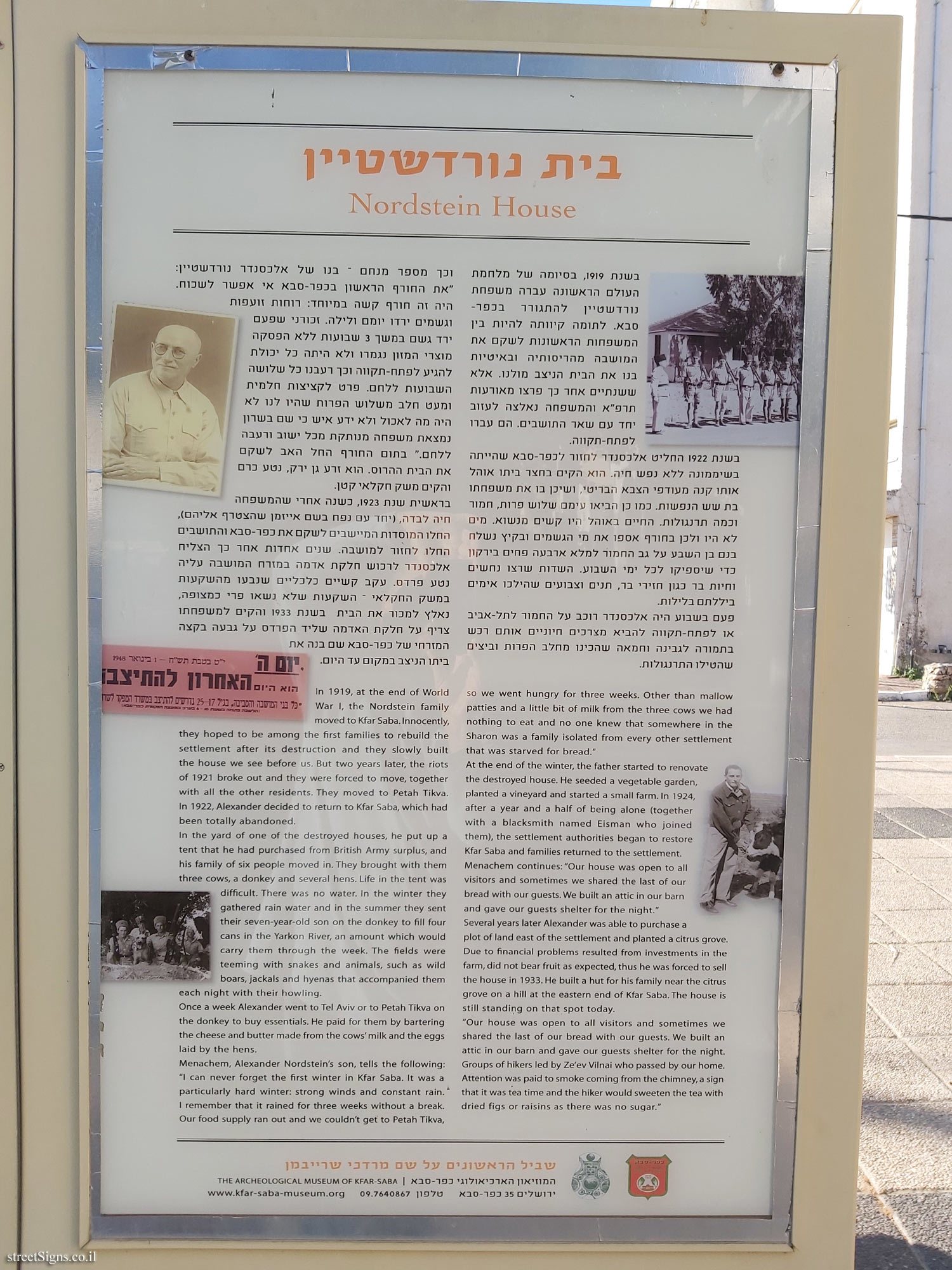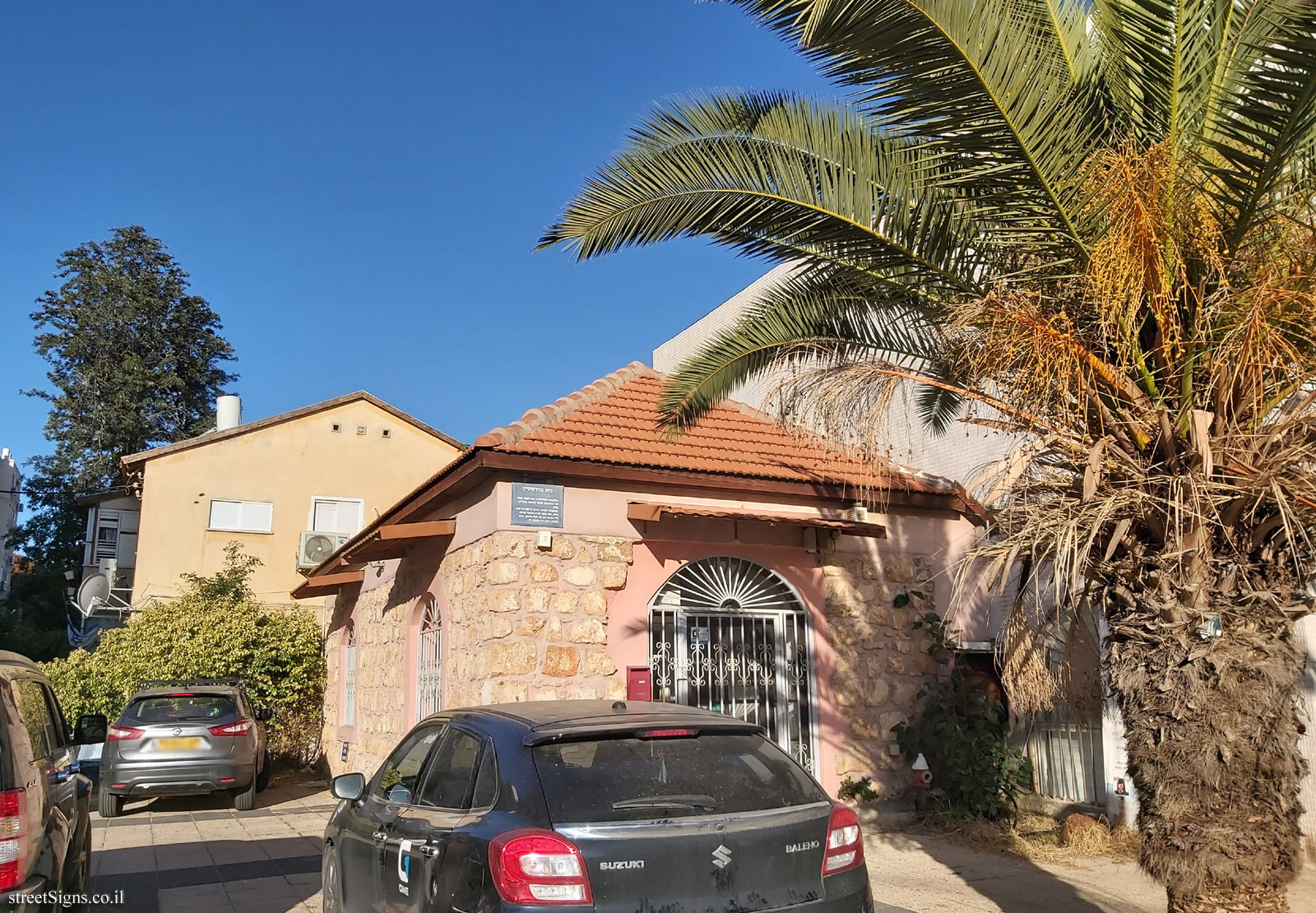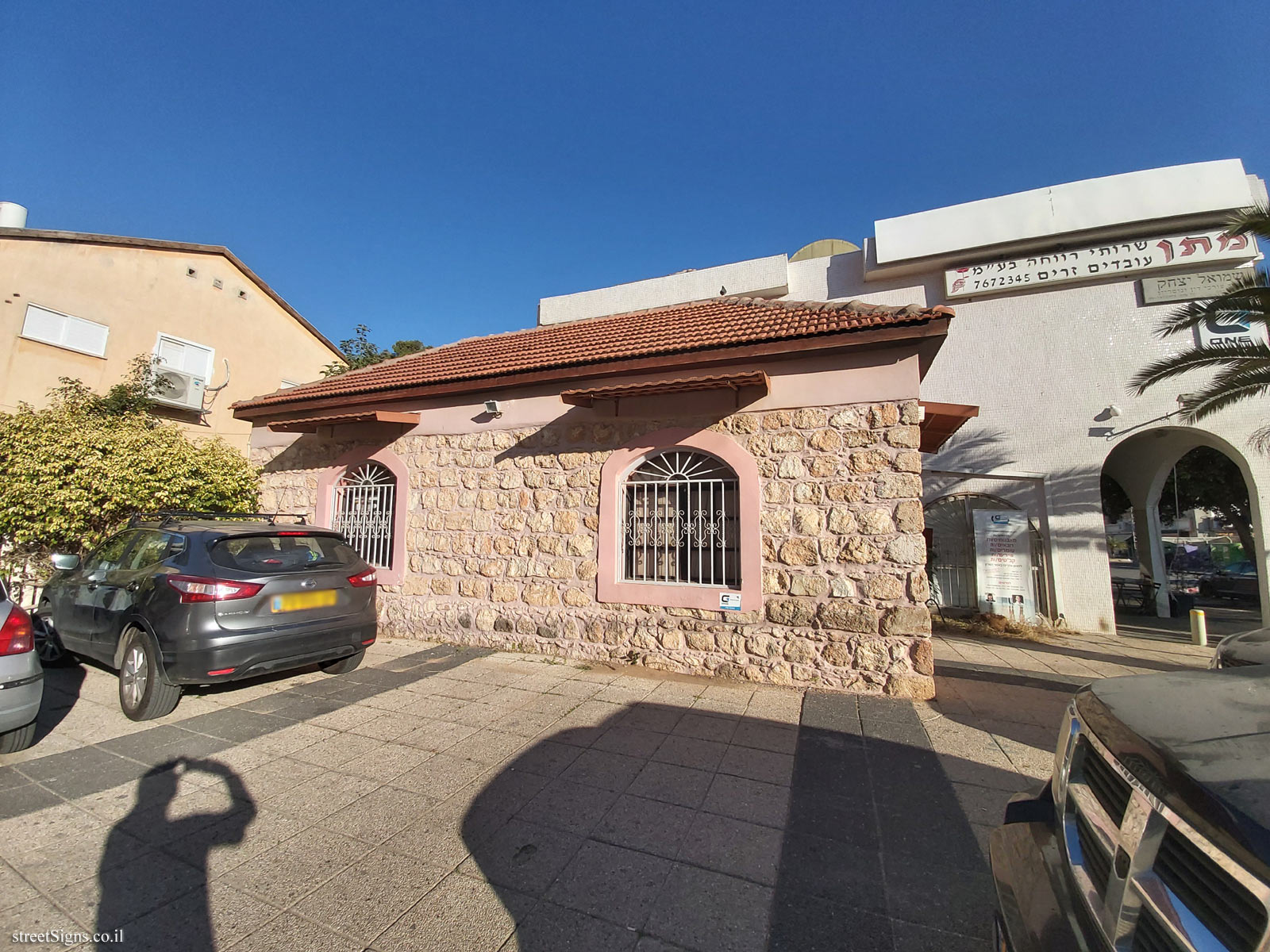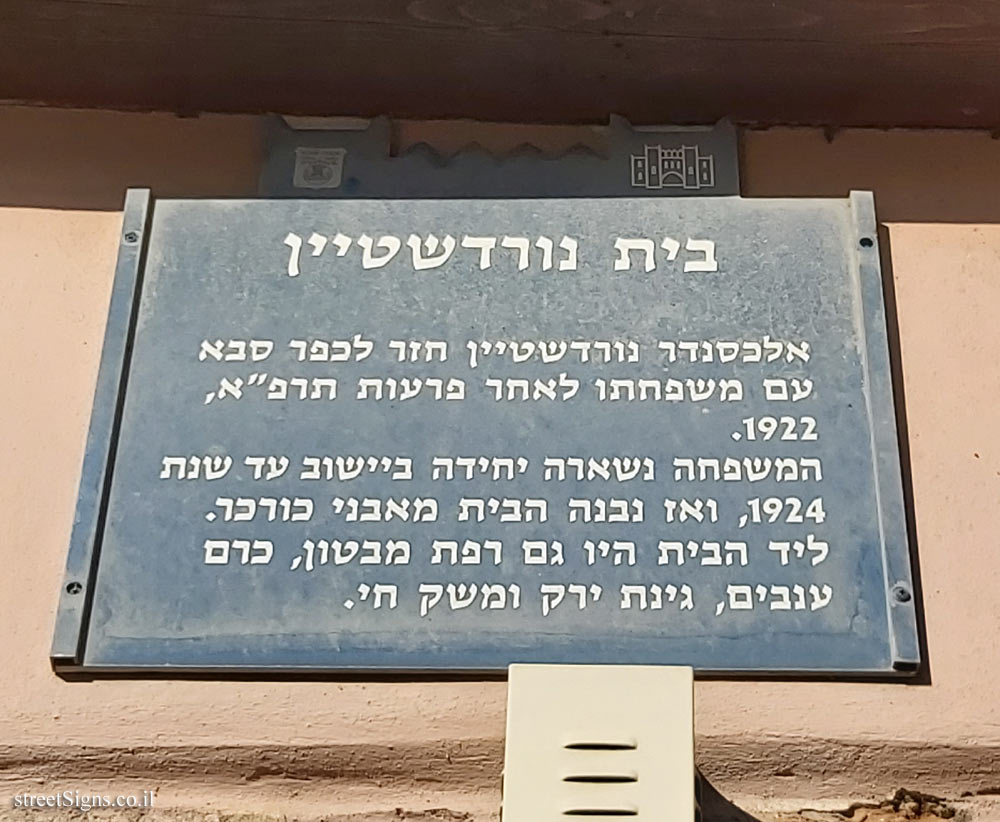On the sign:
[תמונה: בית נורדשטיין]
[מפת השביל]
[הצד השני של השלט]
בית נורדשטיין
Nordstein House
בשנת 1919, בסיומה של מלחמת העולם הראשונה עברה משפחת נורדשטיין להתגורר בכפר-סבא. לתומה קיוותה להיות בין המשפחות הראשונות לשקם את המושבה מהריסותיה ובאיטיות בנו את הבית הניצג מולנו. אלא ששנתיים אחר כך פרצו מאורעות תרפ"א והמשפחה נאלצה לעזוב יחד עם שאר התושבים. הם עבור לפתח-תקווה.
בשנת 1922 החליט אלכסנדר לחזור לכפר-סבא שהייתה בשיממונה ללא נפש חיה. הוא הקים בחצר ביתו אוהל אותו קנה מעודפי הצבא הבריטי, ושיכן בו את משפחתו בת שש הנפשות. כמו כן הביאו עימם שלוש פרות, חמור וכמה תרנגולות. החיים באוהל היו קשים מנשוא. מים לא היו ולכן בחורף אספו את מי הגשמים ובקיץ נשלח בנם בן השבע על גב החמור למלא ארבעה פחים בירקון כדי שיספיקו לכל ימי השבוע. השדות שרצו נחשים וחיות בר כגון חזירי בר, תנים וצבועים שהילכו אימים ביללתם בלילות.
פעם בשבוע היה אלכסנדר רוכב על החמור לתל-אביב או לפתח-תקווה להביא מצרכים חיוניים אותם רכש בתמורה לגבינות וחמאה שהכינו מחלב הפרות וביצים שהטילו התרנגולות.
וכך מספר מנחם - בנו של אכלסנדר נורדשטיין: "את החורף הראשון בכפר-סבא אי אפשר לשכוח. היה זה חורף קשה במיוחד: רוחות זועפות וגשמים ירדו יומם ולילה. זכורני שפעם ירד גשם במשך 3 שבועות ללא הפסקה, מוצרי המזון נגמרו ולא היתה כל יכולת להגיע לפתח-תקווה וכך רעבנו כל שלושה השבועות ללחם. פרט לקציצות חלמית ומעט חלב משלוש הפרות שהיו לנו לא היה מה לאכול ולא ידע איש כי שם בשרון נמצאת משפחה מנותקת מכל ישוב ורעבה ללחם." בתום החורף החל האב לשקם את הבית ההרוס. הוא זרע גן ירק, נטע כרם והקים משק חקלאי קטן.
בראשית שנת 1923, כשנה אחרי שהמשפחה חיה לבדה, (יחד עם נפח בשם אייזמן שהצטרף אליהם), החלו המוסדות המיישבים לשקם את כפר-סבא והתושבים החלו לחזור למושבה. שנים אחדות אחר כך הצליח אלכסנדר לרכוש חלקת אדמה במזרח המושבה עליה נטע פרדס. עקב קשיים כלכליים שנבעו מהשקעות במשק החקלאי - השקעות שלא נשאו פרי כמצופה, נאלץ למכור את הבית בשנת 1933 והקים למשפחתו צריף על חלקת האדמה שליד הפרדס על גבעה בקצה המזרחי של כפר-סבא שם בנה את ביתו הניצב במקום עד היום.
In 1919, at the end of World War I, the Nordstein family moved to Kfar Saba. Innocently, they hoped to be among the first families to rebuild the settlement after its destruction and they slowly built the house we see before us. But two years later, the riots of 1921 broke out and they were forced to move, together with all the other residents. They moved to Petah Tikva. In 1922, Alexandel decided to return to Kfar Saba, which had been totally abandoned.
In the yard of one of the destroyed houses, he put up a tent that he had purchased from British Army surplus, and his family of six people moved in. They brought with them three cows, a donkey and several hens. Life in the tent was difficult. There was no water. In the winter they gathered rain water and in the summer they sent their seven-year-old son on the donkey to fill four cans in the Yarkon River, an amount which would carry them through the week. The fields were teeming with snakes and animals, such as wild boars, jackals and hyenas that accompanied them each night with their howling.
Once a week Alexander went to Tel Aviv or to Petah Tikva on the donkey to buy essentials, He paid for them by bartering the cheese and butter made from the cows’ milk and the eggs laid by the hens.
Menachem, Alexander Nordstein’s son, tells the following: "I can never forget the first winter in Kfar Saba. It was a particularly hard winter: strong winds and constant rain. I remember that it rained for three weeks without a break. Our food supply ran out and we couldn’t get to Petah Tikva, so we went hungry for three weeks. Other than mallow patties and a little bit of milk from the three cows we had nothing to eat and no one knew that somewhere in the Sharon was a family isolated from every other settlement that was starved for bread."
At the end of the winter, the father started to renovate the destroyed house. He seeded a vegetable garden, planted a vineyard and started a small farm. In 1924, after a year and a half of being alone (together with a blacksmith named Eisman who joined them), the settlement authorities began to restore Kfar Saba and families returned to the settlement. Menachem continues: "Our house was open to all visitors and sometimes we shared the last of our bread with our guests. We built an attic in our barn and gave our guests shelter for the night."
Several years later Alexander was able to purchase a plot of land east of the settlement and planted a citrus grove. Due to financial problems resulted from investments in the farm, did not bear fruit as expected, thus he was forced to sell the house in 1933. He built a hut for his family near the citrus grove on a hill at the eastern end of Kfar Saba. The house is still standing on that spot today.
"Our house was open to all visitors and sometimes we shared the last of our bread with our guests. We built an attic in our barn and gave our guests shelter for the night. Groups of hikers led by Ze’ev Vilnai who passed by our home. Attention was paid to smoke coming from the chimney, a sign that it was tea time and the hiker would sweeten the tea with dried figs or raisins as there was no sugar."
סמל העיר כפר סבא
סמל מוזיאון כפר סבא
שביל הראשונים על שם מרדכי שרייבמן
המוזיאון הארכיאולוגי כפר-סבא
ירושלים 35 כפר-סבא
טלפון 09.7640867
THE ARCHAEOLOGICAL MUSEUM OF KFAR-SABA
www.kfar-saba-museum.org

 Click for a larger image
Click for a larger image  Click for a larger image
Click for a larger image  Click for a larger image
Click for a larger image  Click for sign's details
Click for sign's details  Click for sign's details
Click for sign's details